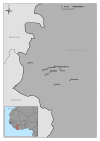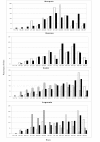Major variations in malaria exposure of travellers in rural areas: an entomological cohort study in western Côte d'Ivoire
- PMID: 19638219
- PMCID: PMC2726180
- DOI: 10.1186/1475-2875-8-171
Major variations in malaria exposure of travellers in rural areas: an entomological cohort study in western Côte d'Ivoire
Abstract
Background: Malaria remains a major threat, to both travellers and military personnel deployed to endemic areas. The recommendations for travellers given by the World Health Organization is based on the incidence of malaria in an area and do not take the degree of exposure into account. The aim of this article is to evaluate the exposure of travellers by entomologic methods, which are the commonly used measures of the intensity of malaria transmission.
Methods: From February 2004 to June 2004, five groups of 30 military personnel were stationed in up to 10 sites in western Côte d'Ivoire, from one week to several months. Adult mosquitoes were collected by human landing catches at each site during the five months and the level of exposure to malaria transmission of each group was estimated.
Results: The level of transmission varied from one site to another one from less than one to approximately more than 100 infective bites per month. In the majority of sites, at least two anopheline species were involved in transmission. The cumulative EIR over the study period varied according to the groups from 29 infected bites per person/per mission to 324.
Conclusion: The level of malaria transmission and malaria risk varies widely (varying by a factor of eleven) between groups of travellers travelling in the same region and at the same time. Physicians involved in travel medicine or supporting expatriated populations or refugees should consider this heterogeneity and emphasize the importance of combining appropriate measures, such as chemoprophylaxis and protective measures against mosquitoes.
Figures




References
-
- Malaria Report from http://www.imea.fr/imea-recherche/imea-rba-chimiosenspalu.php
-
- Malaria vector control and personal protection. World Health Organ Tech Rep Ser. 2006;936:1–62. - PubMed
-
- Pages F, Orlandi-Pradines E, Corbel V. [Vectors of malaria: biology, diversity, prevention, and individual protection] Med Mal Infect. 2007;37:153–161. - PubMed
-
- Touze JE, Debonne JM, Boutin JP. [Current situation and future perspectives for malaria prophylaxis among travellers and military personnel] Bull Acad Natl Med. 2007;191:1293–1302. - PubMed
Publication types
MeSH terms
LinkOut - more resources
Full Text Sources
Medical

